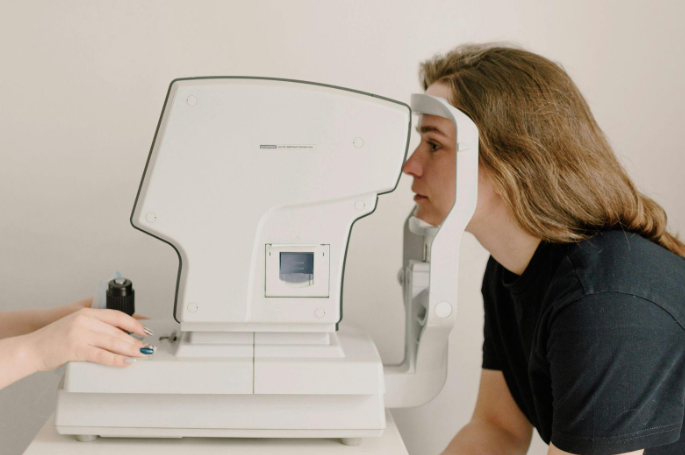Cataracts: Do I Have Them? And More of Your Questions Answered
Cataracts are the leading cause of blindness worldwide and your risk increases with age. If you’re at risk of cataracts, what begins as a little spot of cloudiness in your vision will only grow over time. Cataracts interfere with your ability to perform daily tasks and can prevent you from living the active lifestyle you’ve come to love.
At Baptist Eye Surgeons, it’s our mission to provide you with the highest quality of vision care possible. To help you understand more about cataracts, we’ll take a deep dive into every important aspect of the disease so you know what to look out for and what to do about it.
In this blog we’ll cover:
- What is a cataract
- Cataract symptoms
- Types of cataracts
- What causes cataracts
- How to prevent cataracts
- Cataract treatment
- What to expect during cataract eye surgery
Cataracts are a serious condition, but they’re also a natural part of the aging process. While it’s important to be concerned about anything that can negatively impact your vision, you can rest easy knowing that our team of highly skilled surgeons have your back.
What Is a Cataract?
When healthy, the lens of your eye allows plenty of light to pass through and focuses it on your retina, allowing your eye to work similarly to a film camera. Unfortunately, the lens of your eye can become “clouded” over time, resulting in muddled or blurred vision. This is known as a cataract , and it can severely obstruct your vision and quality of life.
Cataracts are caused by the deterioration of proteins in the lens of the eye. These proteins begin to clump together as they break down, causing the lens to become:
- Cloudy
- Thicker
- Less flexible
Cataracts can have severe repercussions for your vision if left undiagnosed or untreated. On the positive side, it can take years for the broken down proteins to become noticeable enough to affect your vision. Your best bet is to get regular comprehensive eye exams and stay proactive about your vision health. This will help our ophthalmologists catch cataracts early on and develop a treatment plan just for you.
Cataract Symptoms
Symptoms of cataracts can be easily shrugged off early on as minor annoyances. But they aren’t going anywhere once they’ve started growing. Their effects will only become worse as they grow and affect a larger portion of your lens. Pay attention to the symptoms of cataracts so that you know when it’s time to visit us at Baptist Eye Surgeons.
Cataract symptoms include:
- Cloudy or blurred vision
- Double-vision
- Vision that’s faded or has a yellow tint
- Increased sensitivity to light, such as glare
- Seeing halos around lights
- Multiple changes in your eyewear prescription
Experiencing one or even a couple of these symptoms may not seem like a cause for alarm since they’re similar to symptoms of other vision problems you may have. However, they may point to a much more serious eye condition. Even more concerning is that your symptoms won’t get better with time. Instead, they will worsen as the proteins in the lens deteriorate, causing your cataract to grow.
Types of Cataracts
There are different types of cataracts, and they are named based on where they develop on the lens of your eye. Their location can actually determine your symptoms.
The different types of cataracts are:
- Nuclear cataracts
- Posterior subcapsular cataracts
- Cortical cataracts
- Congenital cataracts
Nuclear cataracts are the most common type of cataracts eye doctors run into. These cataracts affect the center of the lens of your eye, resulting in nearsightedness early on and even improved reading vision. Despite making it easier to see things up close, the lens will eventually become clouded, causing your vision to go from yellow to brown, making it more difficult to distinguish colors.
Posterior subcapsular cataracts affect the back of the lense. They begin as a small, clouded area that prevents light from making it to the retina near the back of your eye. This type of cataract makes your reading vision worse, makes it difficult to see in bright light, and can cause glare or halos around light at night. Posterior subcapsular cataracts are more aggressive and tend to develop faster than the other types.
Cortical cataracts are located around the edge of the lens. They start as triangular clouded spots or even streaks near the edge of the lens. These abnormalities gradually stretch to the center of your vision, making it difficult for light to reach the retina, resulting in glare and affect your depth perception. Those with diabetes are at a higher risk for cortical cataracts.
Congenital cataracts are present at birth, though they can also develop during childhood. These types of cataracts may be related to genetics, trauma, or intrauterine infection.

What Causes Cataracts
Cataracts are caused by the breaking down of proteins in the lens of the eye, resulting in the lens becoming hard, less flexible, and cloudy. But this process can be caused by different factors. Knowing the different causes of cataracts, as well as factors that can increase your risk, can help you and your ophthalmologist know what to look out for during regular eye exams.
Cataracts and Getting Older
Aging is the most common reason for cataracts. Deteriorating proteins in the lens of the eye is a natural process that happens to everyone. It starts around the age of 40, with an estimated 24 million Americans having one by that time. By 75, over half of Americans are likely to have cataracts.
Early detection is key when it comes to cataracts. While they start to form around 40 years old, their symptoms don’t usually become noticeable until around the age of 60. Staying proactive about your overall and vision health is key. Keeping up with regular comprehensive eye exams can help catch them in their early stages and give you and your eye doctor time to talk about treatment options.
Family Health History and Cataracts
Your family health history plays an important role in your health and can even be used as a forecast for what to expect when it comes to cataracts. Most people will deal with cataracts eventually, but your genetics may point to a higher risk than others. Having even one close relative with cataracts can signal a much greater chance of developing them than someone who doesn’t.
Talk to your relatives about cataracts and any other medical conditions that may be common in your family. This can be an indicator of what you can expect in the future, your risk for developing cataracts, and what kind of symptoms to keep an eye out for. Make sure to let all of your healthcare providers know what you learn about your family history related to cataracts and other vision problems.
Injuries to the Eye
Cataracts resulting from an eye injury are known as traumatic cataracts . They’re similar to glaucoma in that they can be classified as either “penetrating” or “blunt” injuries. Traumatic cataracts can develop differently and affect your eye in various ways. Your ophthalmologist will be able to determine the best treatment plan for your particular injury or trauma.
Make it a priority to visit your eye doctor if you experience any kind of eye injury or eye trauma. Not only will they be able to treat the initial wound, but they’ll also be able to check for resulting cataracts, as well.
How to Prevent Cataracts
There isn’t a silver bullet for preventing cataracts. They’re a natural part of getting older, making them something that everyone will face at some point in their lives. While that may be true, certain strategies may be helpful in slowing down their effects or preventing them from developing earlier than normal.
Get Regular Comprehensive Eye Exams
They say a good offense is a good defense. In the case of cataracts, the best way to defend yourself from their effects is to regularly get comprehensive eye exams. Comprehensive eye exams are more in-depth than the kinds you may have received in the past. Those were acuity tests designed to catch vision problems that can be corrected with prescription eyewear.
Comprehensive eye exams , on the other hand, are able to detect problems that are much deeper. They enable your ophthalmologist to examine the back of your eye as well as the surface, providing a much fuller picture of your vision health. For cataracts, your ophthalmologist can examine the front of your eye using a biomicroscope and the back with an ophthalmoscope.
You’ll want to get a comprehensive exam once per year, especially if you have diabetes or are over the age of 40. This won’t only help your eye doctor catch cataracts. It will help them to identify any other problems with your eye health and develop a plan to treat them.
Stop Smoking
Some causes of cataracts are beyond our control. You can’t stop the aging process or change your DNA, but you can do something about risk factors like smoking. The CDC has reported that smokers have a significantly higher chance of developing cataracts than nonsmokers, so it’s best to quit now to slow down or even prevent them from developing early.
If you are a smoker, your best option is to quit immediately. This will not only help in the fight against cataracts, but it can also help prevent smoking-related eye diseases such as age-related macular degeneration (AMD). By quitting now, you’ll help slow down or even prevent multiple health issues.
Manage Your Blood Sugar
Diabetes can have a huge impact on your health, including increasing your chances of developing cataracts. Experts aren’t sure why, but research has shown that people living with diabetes have a 60% higher chance of developing cataracts than those who don’t.
Managing your blood sugar is essential for preventing cataracts as other complications related to diabetes. Those with type 2 diabetes who are able to lower their glucose levels by just 1% have seen their risk of cataracts drop by 19%. This will help prevent other diabetic eye conditions, such as diabetic retinopathy , as well.
Avoid Getting Too Much Sun
The light from the sun has tons of benefits, including helping you get better sleep , but it also has a dark side. Along with damaging your skin, prolonged exposure to UV radiation can increase your chances of developing cataracts or even speed up the process. This also goes for artificial sources of UV radiation like tanning beds.
You need to protect your eyes as much as you protect your skin when spending time outside. This means investing in a quality pair of sunglasses to protect your eyes for the long haul. When shopping for sunglasses , choose a pair that has:
- High UV absorption (99 – 100% or 400nm)
- A good fit to prevent as much light from entering as possible
- Durable lenses
The quality of the lenses is also important. While you want to block UV rays, you don’t want to choose a pair that makes it difficult to see. You can test them by looking at the lines around objects when trying them on. Avoid sunglasses that create wavy lines and opt for a pair where lines are straight.

Cataract Treatment
The only effective treatment for cataracts is surgery. However, cataracts can usually be treated in their early stages with:
- An updated prescription for contacts or glasses
- Anti-glare glasses or sunglasses
- Brighter lighting
- Magnifying glasses
Eye doctors are likely to suggest these solutions during the early stages due to how cataracts grow. Cataracts typically grow very slowly. While they aren’t reversible without surgery, eyecare professionals are likely to wait until the cataract begins to interfere with your daily life before recommending surgery.
But don’t let the slow nature of cataracts lull you into complacency. They may not harm the eye, but cataracts can eventually make it much more difficult to engage in activities such as reading or driving at night.
Make sure to have a plan in place once you have been diagnosed with cataracts. If you choose to delay surgery, then your doctor will keep tabs on how your cataract develops until they feel that it’s time. If you opt to go ahead with surgery, then your eye doctor may suggest follow-up exams to see how the treatment is progressing.
Cataract Eye Surgery in Knoxville, TN
Eventually, your cataract will reach the point where solutions such as a new prescription, magnifying glasses, or brighter lighting will no longer do the trick. Cataract surgery is the only method of treatment that’s effective against cataracts. Without it, you’ll no longer be able to perform regular tasks like driving at night or living the active lifestyle that you love. This is often the point when most people qualify for cataract eye surgery.
Cataract surgery can do wonders for your vision and quality of life. Over 95% of patients experience improved vision after surgery, meaning that they can perform daily tasks the way they used to as well as return to the activities they once enjoyed.
Our team of surgeons are leaders in the field of cataract eye surgeons. They are experienced with the latest advancements in cataract treatment, including the application of advanced artificial lenses. Our team is always staying at the forefront of the most innovative techniques and technologies, giving you a fast and secure return to your normal life.
What to Expect During Cataract Eye Surgery
The purpose of cataract eye surgery is to replace your old lens with a new one. The old lens has become clouded and occluded, making it at best an annoyance and at worst a genuine danger to your wellbeing. By replacing the old, clouded lens with a new one, you’ll be able to live your life to the fullest again.
You will be provided with a local anesthetic before cataract surgery. Patients are usually awake during cataract procedures, but the local anesthetic will numb your eye so you don’t feel anything during the operation.
During the procedure, one of our surgeons will gently remove the old lens and replace it with a new, artificial one. This is known as an intraocular lens , and it can come in a couple of different types. One is the toric lens , which can correct astigmatism as well as improve distance vision. Another is a multifocal lens , which improves near, distant, and intermediate vision. In some instances, artificial multifocal lenses may even remove the need for corrective eyewear.
Unfortunately, prosthetic lens replacements aren’t right for everyone. This is often the result of having other eye disorders along with cataracts. But this doesn’t mean that your cataracts are untreatable! Patients in this position can still have their cataracts removed. In this case, prescription eyeglasses or contact lenses can be used to correct vision problems.
Despite the complexity of cataract surgery, we are able to perform cataract eye surgery on an outpatient basis. This allows us to complete the procedure as safely as possible while enabling you to return to your daily routine as quickly as possible.
Types of Intraocular Lenses
Intraocular lenses for cataract surgery come in three types:
- Standard
- Toric
- Multifocal
Standard cataract lenses are usually covered by insurance and are helpful in treating nearsightedness and farsightedness. Unfortunately, they aren’t helpful in treating astigmatism. They can improve near vision and distance vision, but not both. You’ll need reading glasses with standard cataract lenses or possibly bifocals.
Toric cataract lenses are not covered by insurance. However, they are able to treat astigmatism along with nearsightedness and farsightedness. Like standard cataract lenses, they can fix near vision or distance vision but not both. They can help reduce your dependency on glasses but reading glasses may still be necessary.
Multifocal cataract lenses aren’t covered by insurance, but they are able to treat all forms of refractive error. They can also decrease your dependence on glasses, including the need for reading glasses. Some patients may not even need glasses at all while others may still need them for reading small print or driving at night.
Recovering from Cataract Surgery
Discomfort is common a few days after cataract surgery. The recovery process usually lasts around eight weeks, but most patients are able to return to their jobs shortly after the procedure. Office-workers can usually return to work a few days after surgery while those in vocational fields often go back after one week.
Healthy, clear lenses allow light to pass through to support your vision. Unfortunately, the lens can become thick, clouded, and hard. These are known as cataracts and can come in different types and have different causes. Although certain strategies may slow their progression or even prevent them from developing early, surgery will eventually become necessary to remove the cataract and its effects. Our team of Knoxville eye surgeons can perform cataract surgery on an outpatient basis and get you back on your feet as quickly and safely as possible.
Do you suspect that you have a cataract? If so, contact us today and schedule your comprehensive eye exam.
Baptist Eye Surgeons is an ophthalmological practice in Knoxville, TN, and Morristown, TN. Give us a call at 865-579-3920 for more information or to schedule an appointment.





